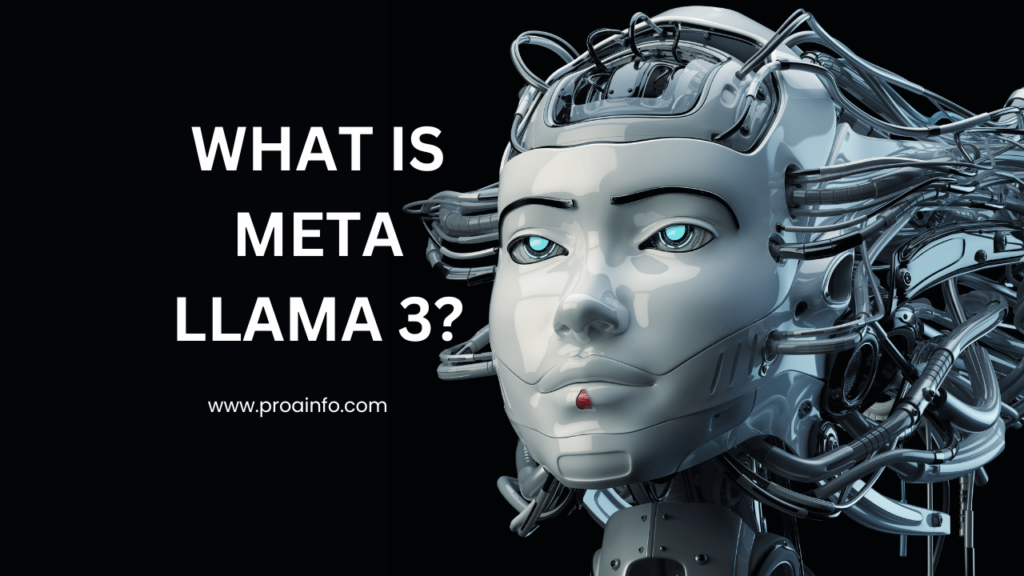What is Meta Llama 3? In the rapidly evolving world of artificial intelligence, Meta (formerly Facebook) has emerged as a trailblazer, constantly pushing the boundaries of what is possible.
Among their latest innovations is the Meta LLaMA 3 (Large Language Model Adapted), a state-of-the-art language model that promises to revolutionize the way we interact with and leverage AI technology.
This article delves deep into the intricacies of Meta LLaMA 3, exploring its underlying architecture, capabilities, and potential applications, while also addressing the ethical considerations surrounding such powerful AI models.
The Rise of Large Language Models
Before diving into the specifics of Meta LLaMA 3, it is essential to understand the context in which it emerges. Large language models (LLMs) have been at the forefront of recent advancements in natural language processing (NLP) and AI. These models are trained on vast amounts of textual data, enabling them to understand and generate human-like language with remarkable fluency and coherence.
The success of models like GPT-3 (Generative Pre-trained Transformer 3) by OpenAI and BERT (Bidirectional Encoder Representations from Transformers) by Google has demonstrated the immense potential of LLMs in various applications, from content generation and language translation to question answering and text summarization.
Meta LLaMA 3: A Groundbreaking Language Model

Meta LLaMA 3 is the latest iteration of Meta’s large language model, building upon the successes and learnings of its predecessors. This cutting-edge model represents a significant leap forward in terms of scale, performance, and capabilities.
Architecture and Training
At the core of Meta LLaMA 3 lies a transformer-based neural network architecture, which has become the industry standard for state-of-the-art language models. This architecture allows the model to capture intricate relationships and dependencies within the input data, enabling it to generate highly coherent and contextually relevant outputs.
What sets Meta LLaMA 3 apart is the sheer scale of its training data and computational resources. The model has been trained on an unprecedented volume of textual data, spanning a wide range of domains and languages. This massive training corpus, combined with Meta’s state-of-the-art hardware and software infrastructure, has enabled the model to achieve unprecedented levels of linguistic understanding and generation capabilities.
Key Features and Capabilities
Meta LLaMA 3 boasts a multitude of impressive features and capabilities that make it a truly remarkable language model:
- a. Multilingual Support: One of the standout features of Meta LLaMA 3 is its ability to understand and generate text in multiple languages simultaneously. This multilingual capability is crucial in an increasingly globalized world, enabling seamless communication and collaboration across linguistic barriers.
- b. Contextual Understanding: Meta LLaMA 3 excels at understanding and generating text within specific contexts. By leveraging its vast knowledge base and advanced language understanding capabilities, the model can provide highly relevant and contextually appropriate responses, making it invaluable for applications such as virtual assistants, chatbots, and content personalization.
- c. Open-Domain Knowledge: Unlike many language models that are trained on specific domains or tasks, Meta LLaMA 3 has been exposed to a vast array of knowledge domains during its training. This open-domain knowledge allows the model to engage in substantive conversations and tackle a wide range of topics and tasks with remarkable proficiency.
- d. Few-Shot Learning: One of the most impressive features of Meta LLaMA 3 is its ability to adapt to new tasks and domains with minimal additional training, a capability known as few-shot learning. This flexibility allows the model to be quickly fine-tuned for specific applications, significantly reducing the time and resources required for deployment.
- e. Creative Generation: Beyond just understanding and generating coherent text, Meta LLaMA 3 also exhibits remarkable creative capabilities. The model can generate original content, such as stories, poems, and scripts, while maintaining a high level of coherence and contextual relevance.
Applications and Use Cases
The breadth of capabilities offered by Meta LLaMA 3 opens up a world of potential applications across various industries and domains. Here are some key areas where this language model is poised to make a significant impact:
Natural Language Processing (NLP) and Language Technology

As a cutting-edge language model, Meta LLaMA 3 is expected to drive advancements in a wide range of NLP tasks, including:
- a. Machine Translation: With its multilingual capabilities, Meta LLaMA 3 can facilitate high-quality machine translation between various language pairs, enabling seamless communication across linguistic boundaries.
- b. Text Summarization: The model’s ability to comprehend and synthesize information makes it well-suited for automatic text summarization tasks, allowing for efficient information extraction and knowledge distillation.
- c. Sentiment Analysis: By leveraging its contextual understanding, Meta LLaMA 3 can accurately identify and analyze the sentiment expressed in textual data, making it valuable for applications such as social media monitoring and customer experience analysis.
- d. Named Entity Recognition: The model’s advanced language understanding capabilities enable accurate identification and classification of named entities (e.g., people, organizations, locations) within text, a critical component of many NLP pipelines.
Virtual Assistants and Conversational AI
One of the most promising applications of Meta LLaMA 3 lies in the realm of virtual assistants and conversational AI. With its ability to understand and generate human-like language, the model can power intelligent virtual assistants capable of engaging in natural, contextual conversations across a wide range of topics and tasks.
These virtual assistants can be integrated into various platforms and devices, providing users with a seamless and intuitive interface for accessing information, performing tasks, and receiving personalized recommendations and support.
Content Creation and Generation
Meta LLaMA 3’s creative generation capabilities open up new frontiers in content creation and generation. The model can be leveraged to generate original and high-quality content, such as articles, stories, scripts, and marketing materials, while ensuring consistency, coherence, and adherence to specific guidelines or styles.
This has significant implications for industries such as media, entertainment, and advertising, where the ability to generate engaging and relevant content at scale can be a game-changer.
Education and E-Learning

The educational sector can also benefit greatly from the capabilities of Meta LLaMA 3. The model can be used to develop intelligent tutoring systems and personalized learning platforms, providing students with tailored learning experiences and adaptive support based on their individual needs and progress.
Additionally, Meta LLaMA 3 can be used to generate educational content, such as lessons, exercises, and assessments, ensuring consistency and accuracy across various subjects and curricula.
Ethical Considerations and Challenges
While the potential applications of Meta LLaMA 3 are undoubtedly exciting, it is crucial to address the ethical considerations and challenges associated with such powerful language models.
Bias and Fairness
Like any AI system trained on human-generated data, Meta LLaMA 3 is susceptible to inheriting biases present in its training data. These biases can manifest in the form of discriminatory or offensive language, perpetuating harmful stereotypes or reinforcing societal inequalities.
Addressing these biases is a critical challenge, requiring rigorous debiasing techniques, careful data curation, and ongoing monitoring and evaluation. Meta and the broader AI community must work collaboratively to develop and implement strategies that mitigate these biases, promoting fairness, inclusivity, and ethical AI practices.
Privacy and Security Concerns
As language models become more advanced and capable of generating highly realistic and coherent text, there are legitimate concerns regarding the potential misuse of these technologies for malicious purposes, such as generating fake news, impersonating individuals, or spreading misinformation.
Robust security measures and safeguards must be implemented to prevent unauthorized access and misuse of Meta LLaMA 3 and similar language models. This may include techniques such as watermarking, model fingerprinting, and access control mechanisms, among others.
Additionally, there is a need for clear guidelines and regulations governing the responsible development and deployment of these technologies, ensuring that they are used in an ethical and transparent manner.
Environmental Impact and Sustainability
The training and deployment of large language models like Meta LLaMA 3 require significant computational resources, which can have a substantial environmental impact in terms of energy consumption and carbon emissions.
As AI continues to advance, it is crucial to address these sustainability challenges by developing more energy-efficient hardware and software solutions, leveraging renewable energy sources, and optimizing model architectures and training processes to reduce their environmental footprint.
The Future of Meta LLaMA 3 and Language Models
Despite the challenges and ethical considerations, the future of Meta LLaMA 3 and large language models in general is incredibly promising. These models are poised to drive transformative changes across various industries and domains, reshaping the way we interact with technology and approach problem-solving.
Continuous Improvement and Scalability
One of the defining characteristics of large language models is their ability to continuously improve and scale as more data and computational resources become available. As training datasets grow larger and more diverse, and as hardware capabilities advance, models like Meta LLaMA 3 will become even more powerful, accurate, and capable.
This scalability also opens up opportunities for specialization and fine-tuning, where language models can be tailored to specific domains or tasks, further enhancing their performance and applicability in niche areas.
Multimodal Integration

While language models like Meta LLaMA 3 excel at processing and generating textual data, the future lies in the integration of multimodal capabilities. By combining language understanding with computer vision, speech recognition, and other modalities, these models can evolve into truly intelligent systems capable of perceiving and interacting with the world in a more holistic and human-like manner.
Multimodal integration will enable a new generation of AI assistants that can not only understand natural language but also perceive and interpret visual and auditory information, opening up possibilities for applications in areas such as robotics, augmented reality, and human-computer interaction.
Human-AI Collaboration and Augmentation
Rather than viewing large language models as replacements for human intelligence, the future lies in fostering a symbiotic relationship between humans and AI. Meta LLaMA 3 and similar models have the potential to augment human capabilities, acting as powerful cognitive assistants and decision-support systems.
By leveraging the vast knowledge and processing power of these models, humans can offload tedious or complex tasks, freeing up cognitive resources for higher-level reasoning, creativity, and decision-making. This human-AI collaboration can lead to unprecedented levels of productivity, innovation, and problem-solving across various domains.
Responsible AI and Governance
As language models continue to advance and their applications become more widespread, it is imperative to establish robust frameworks for responsible AI development and governance. This includes ongoing efforts to address bias, ensure privacy and security, promote transparency and accountability, and align these technologies with ethical principles and societal values.
Collaborative efforts between technology companies, academic institutions, policymakers, and civil society organizations will be crucial in shaping the future of large language models like Meta LLaMA 3, ensuring that their development and deployment prioritize the well-being and best interests of humanity.
Conclusion
Meta LLaMA 3 represents a significant milestone in the evolution of large language models and artificial intelligence as a whole. Its impressive capabilities, ranging from multilingual support and contextual understanding to open-domain knowledge and creative generation, position it as a game-changer across various industries and domains.
However, as with any powerful technology, the responsible development and deployment of Meta LLaMA 3 and similar models require careful consideration of ethical implications, addressing issues of bias, privacy, security, and environmental impact.
The future of language models lies in continuous improvement, scalability, multimodal integration, and fostering a symbiotic relationship between humans and AI. By embracing responsible AI practices and establishing robust governance frameworks, we can harness the full potential of these technologies while ensuring that they prioritize the well-being and best interests of humanity.
As we stand on the precipice of a new era in artificial intelligence, Meta LLaMA 3 serves as a remarkable testament to the boundless potential of human ingenuity and the transformative power of language and technology.
FAQs
What is Meta LLaMA 3?
Meta LLaMA 3 (Large Language Model Adapted) is a state-of-the-art large language model developed by Meta (formerly Facebook). It is a cutting-edge artificial intelligence system capable of understanding and generating human-like language with remarkable fluency and coherence.
How does Meta LLaMA 3 work?
Meta LLaMA 3 is based on a transformer-based neural network architecture, which allows it to capture intricate relationships and dependencies within textual data. It has been trained on an unprecedented volume of textual data from various sources, enabling it to understand and generate natural language with superior accuracy and contextual relevance.
What are the key features of Meta LLaMA 3?
Some of the standout features of Meta LLaMA 3 include multilingual support, contextual understanding, open-domain knowledge, few-shot learning (ability to adapt to new tasks with minimal training), and creative generation capabilities.
What are the potential applications of Meta LLaMA 3?
Meta LLaMA 3 has a wide range of potential applications, including natural language processing tasks (e.g., machine translation, text summarization, sentiment analysis), virtual assistants and conversational AI, content creation and generation, and educational applications such as intelligent tutoring systems and personalized learning platforms.
How does Meta LLaMA 3 address bias and fairness issues?
Like any AI system trained on human-generated data, Meta LLaMA 3 is susceptible to inheriting biases present in its training data. Addressing these biases is a critical challenge, and Meta is working on rigorous debiasing techniques, careful data curation, and ongoing monitoring and evaluation to promote fairness and inclusivity.
What are the privacy and security concerns surrounding Meta LLaMA 3?
As language models become more advanced, there are legitimate concerns about their potential misuse for malicious purposes, such as generating fake news, impersonating individuals, or spreading misinformation. Robust security measures, access control mechanisms, and clear guidelines and regulations are crucial to prevent unauthorized access and misuse.
How does Meta LLaMA 3 address environmental sustainability?
The training and deployment of large language models like Meta LLaMA 3 require significant computational resources, which can have a substantial environmental impact in terms of energy consumption and carbon emissions. Meta is exploring energy-efficient hardware and software solutions, renewable energy sources, and optimized model architectures to reduce the environmental footprint.
What is the future of Meta LLaMA 3 and language models?
The future of Meta LLaMA 3 and language models lies in continuous improvement and scalability, multimodal integration (combining language with vision, speech, etc.), human-AI collaboration and augmentation, and responsible AI development with robust governance frameworks.
How can I access or use Meta LLaMA 3?
Meta LLaMA 3 is a proprietary model developed by Meta, and its availability and access protocols may vary. Interested parties should refer to Meta’s official channels and resources for the latest information on accessing or utilizing the model for research or commercial purposes.
What are the ethical considerations surrounding Meta LLaMA 3?
While Meta LLaMA 3 holds immense potential, its development and deployment must be accompanied by careful consideration of ethical implications, addressing issues such as bias, privacy, security, and environmental impact. Collaborative efforts between technology companies, academic institutions, policymakers, and civil society organizations are crucial in ensuring the responsible and ethical use of these technologies.







